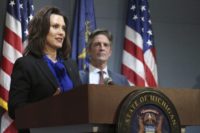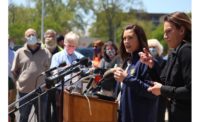Illinois Gov. J.B. Pritzker [D] on March 20 ordered most state residents to stay in their homes as COVID-19 proliferates. A cascading effect of similar orders happened over the next five days in six other Midwestern states.
[For ENR’s latest coverage of the impacts of the COVID-19 pandemic, click here]
Construction falls under an exception to the Illinois governor's executive order. The industry falls under "essential infrastructure" in Pritzker's order and critical trades are included in a separate exemption. March 22, Ohio Gov. Mike DeWine [R] followed suit with a similar order that also exempted construction as essential infrastructure that uses the same language to define it as the Illinois order. On March 23, Indiana Gov. Eric Holcomb [R] issued a stay at home order that had identical language as the Ohio and Illinois orders regarding construction as essential infrastructure. That morning, Michigan Gov. Gretchen Whitmer [D] issued a stay at home order with different language but a provision that has an exception for anyone "to perform their jobs as critical infrastructure workers after being so designated by their employers." On March 24, Wisconsin Gov. Tony Evers [D] released a "safe at home" executive order with language identical to the Illinois, Indiana and Ohio orders on construction as essential infrastructure. On March 25, Minnesota Gov. Tim Walz [D] announced a stay-at-home order for his state that has similar language to the Illinois, Indiana, Ohio and Wisconsin orders and Kentucky Gov. Andy Beshear [D] changed his state's "healthy at home" policy to a stay at home executive order. On March 28, Kansas Gov. Laura Kelly [D] announced a stay-at-home order with similar language to the Minnesota one. On April 3, Missouri Gov. Mike Parson [R] declared a statewide stay-at-home order.
"Construction is considered essential under the stay at home order," according to Jordan Abudayyeh, press secretary to Illinois Gov. Pritzker.
The Illinois order was scheduled to expire April 7 but was extended through April 30 by Pritzker on March 31. The Ohio and Indiana orders expire April 7 and the Wisconsin order expires April 24. The Michigan order runs through at least April 14. The Minnesota order expires April 10. The Kansas order runs through April 19. Work can continue on sites in Ohio, Indiana, Illinois and Wisconsin, "including, but not limited to, construction required in response to this public health emergency, hospital construction, construction of long-term care facilities, public works construction, and housing construction."
The Illinois, Indiana, Ohio and Wisconsin orders further state that "essential Infrastructure shall be construed broadly to avoid any impacts to essential infrastructure, broadly defined."
When asked about how the order will affect construction in the state, Michigan Governor Whitmer's press secretary said there are exceptions for construction available to the order, but contractors may have to get state approval to continue work.
"Some limited forms of construction are permissible, including construction to maintain and improve essential public works like roads, bridges, the telecommunications infrastructure, and public health infrastructure. Construction workers may also undertake such projects as necessary to maintain and improve the safety, sanitation, and essential operations of residences," says Tiffany Brown, press secretary to Gov. Whitmer. "In addition, businesses may designate construction firms to provide necessary support to the work of the businesses' critical infrastructure workers. All construction work that is carried out while the order is in effect must be done in accordance with the mitigation measures required under section 5(c) of the order."
Two of the projects that are continuing with new precautions in place in Michigan are the $5.7-billion Gordie Howe Bridge and the $629-million Interstate 75 reconstruction.
The Michigan order is singular among Midwestern states in that it refers to a U.S. Cybersecurity and Infrastructure Security Agency's March 19, 2020 memorandum that recommends exempting public works and other community-based government operations and essential functions as part of the COVID-19 response, but does not use the "construed broadly" language of the other orders or use a definition of outdoor activities that includes construction.
The Minnesota order does not have the "essential infrastructure" language as the Illinois, Indiana, Ohio or Wisconsin orders do, but it does include a similar provision that workers engaged in roadway construction, maintenance, and utility projects are exempt and it also includes another provision that specifically exempts "outdoor activities," which includes work on most construction sites. There is also a "construction and critical trades" exemption that encompasses "workers in the skilled trades such as electricians, plumbers, HVAC and elevator technicians, and other related construction of all kind[s]," in the Minnesota order.
The Kansas order has language that exempts "critical infrastructure," which, under the order, includes the construction, repair, maintenance and cleaning of both roads and buildings. Similar language exists in Missouri and Kentucky's orders.
Nebraska and Iowa have not yet issued statewide stay-at-home orders.
Several other exemptions outlined in Ohio, Indiana, Illinois, Minnesota, Missouri, Kansas, Kentucky and Wisconsin's orders include essential workers in law enforcement, health care, pharmacies, clinics, grocery stores, delivery and service stations, as well as essential services such as public transit, highways and airports. Those businesses are also exempted in the Michigan order, but under different language.
Manufacturing, banking and other industries also have exemptions in all seven states.
In his press conference announcing the Illinois stay at home order, Pritzker said the decision was made in consultation with state public health officials and outside experts such as Dr. Emily Landon, lead epidemiologist at the University of Chicago. She said it would take more than a week to determine if the rate of infection has slowed and longer for it to begin decreasing.
State health officials have reported 422 confirmed cases of the novel coronavirus and four deaths across 22 Illinois counties.
"We all acknowledge that this is the only way forward," Landon said at a news conference. "We cannot take care of everyone at once and keep that low mortality promise."
Landon said that waiting for hospitals to be overwhelmed will leave patients with nowhere to go if a shelter at home restriction was not enacted.
Best Advice
"We are in uncharted territory, so we are doing just everything possible" to help employees stay safe, say Michael Meagher, president of both Chicago-based James McHugh Construction Co. and the Chicago Associated General Contractors group. "We're having a 7 a.m. phone call every day with the [AGC ] executive team, trying to be responsive to our projects and sending out a daily update to all employees by [about 10 a.m. every day with any updates of what's going on."
He said the goal of local contractors is to take the experts' best advice and to respond accordingly.
McHugh's projects in downtown Chicago include the $1-billion Vista Tower, which is set to finish this year, and a $100 million 1000M condo tower that began construction last December.
"If the experts tell us not to work, we're going to comply with that," he says. "We are not pushing one way or the other. We want the safest possible way, so we're relying on the experts and our political leadership to give us a direction to go."
Before the order was issued, the Chicago area AGC group considered doing daily worker temperature checks at all jobsites, developing a protocol and ordering thermometers and testing equipment. The effort's start was delayed for one week, with late arriving equipment.
At least one Chicago contractor had been using infrared cameras to monitor temperature in the interim.
"We're just trying to make sure we have a healthy workforce," Meagher says.
Regional Precautions
In St. Louis, the U.S. Army Corps of Engineers said that no decisions have been made about the National Geospatial Intelligence Agency' $1.7-billion new campus, the largest construction project in the city's history. Site work began late last year but major construction has not yet started.
The Corps said in a statement that related to work progress, "it is too early to tell due to new information coming in daily."
McCarthy Building Cos., part of the project's JV general contractor with HITT Construction, said that it was allowing personnel to work from home where possible and monitoring the situation on all its work sites.
"Currently we are paying close attention to developments and actively monitoring and complying with the direction of the Centers for Disease Control and Prevention (CDC), in conjunction with federal, state and local health agencies, and relevant government entities," the firm said.
McCarthy said all its project teams are evaluating specific project requirements to institute recommended social distancing protocols and staffing as well as having office staff work from home, among other measures.
Meagher says that the longer the coronavirus remains a threat to public health, the more it will threaten work further down contractors' pipelines and endanger construction markets across the entire region.
"How quick can we recover? How quick can we get back to normal or a new normal is the question we hear," he says.
"Somebody mentioned the polar vortex [in Chicago in 2019]. That was a blip in time that you knew was going to end. There was some predictability to that," Meagher contends. "This is completely different."
Editor's note: This story was updated on March 23 to reflect the Indiana, Michigan and Ohio orders, on March 24, 2020 to reflect the Wisconsin executive order and the comments of press secretaries Abudayyeh (Ill.) and Brown (Mich),a third time on March 25 after Minnesota's order was made, a fourth time March 26, a fifth time on March 30 to reflect the Kansas order, a sixth tine March 31 to reflect Illinois Governor Pritzker's extension of the stay-at-home order and a sixth time April 3 to reflect the Missouri and Kentucky orders.






Post a comment to this article
Report Abusive Comment